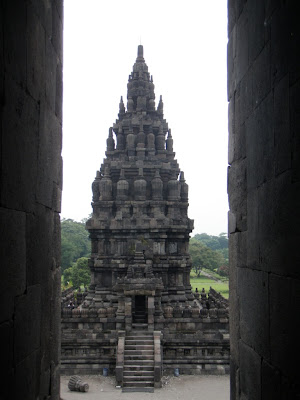We woke up early to join the Borodubur Sunrise Tour at 4.30am. The Borobudur temple complex is accessible from the Manohara Hotel where we stayed the night and a guide from the hotel led us there. The sunrise tour, which costs Rp150,000 each for guests staying in Manohara Hotel, will allow us 1.5 hours of uninterrupted access to the temple complex before the gate opens at 6am for the public.


Borobudur at dawn

The reddish yellow light of the sun emerges

Borobudur after the sunrise
The sun rose slightly late that day and by the time it was bright enough to explore the temple, throngs of people, especially local school children on field trips. The guide our group hired, Fatah, was excellent. He speaks fluent English, and has extensive knowledge of the history of Borobudur, as well as the stories and teachings behind many carvings and reliefs.
(Extracted from Wikitravel)
An ancient Buddhist stupa and temple complex, Borobudur was built over a period of some 75 years in the 8th and 9th centuries by the kingdom of Sailendra. Reputed to be the largest Buddhist monument in the world, it was constructed out of an estimated 1,600,000 blocks of volcanic stone, dredged from the river and assembled solely by human labor. The nine-terraced temple is a representation of the transition towards nirvana and is famed for its 1,500 intricately carved reliefs, covering a total length of five kilometers end-to-end.
The first archaeological study of the site was initiated in 1814 by Sir Stamford Raffles, founder of Singapore. He did not set foot to look for it himself, but commissioned a Dutch engineer, H.C.Cornellius. First restored in 1907, the monument suffered from neglect and war and was rebuilt once again in the 1970s under the guidance of UNESCO, who designated Borobudur as a World Heritage Site. The massive restoration process involved the removal and refurbishing of over one million blocks, rebuilding the foundation and adding drainage systems.
A group photo at the base of Borobudur

My attempt at making a panoramic photo of Borobudur

Borobudur was constructed as a ten-terraces building. The first six terraces are in square form, three upper terraces are in circular form, and on top of them is the grand central stupa. The base of Borobudur (consisting of the first two square terraces), called Kamadhatu symbolizes human being that are still bound by lust and greed. A section of the platform has been excavated at the southeast corner, showcasing some of the hidden reliefs underneath.

The upper four square terraces are called Rupadhatu symbolizing human beings that have set themselves free from lust and greed, but are not yet able to transcend the material world.

Top left: McD had its beginning here? Bottom left: Borobudur is constructed with blocks of stones held together by "male" and "female" mechanisms like this. Right: This demon face structure actually acts as irrigation system

The many carvings of Rupadhatu

Buddha statues without, and with head. Many of the Buddha statues have missing heads
The next three circular terraces where Buddha effigies are confined in bell-shaped domes with lattices (stupas) are called Arupadhatu, where the liberated human spirits have left earthly consideration behind.



One of the stupas is considered to be sacred and if one can stretch forth your hand to touch the Buddha, one’s wishes will come true. Males are supposed to touch the right ring finger of the Buddha in a meditative position, while females are supposed to touch the base of the Buddha’s right heel.

The females' turn to try their luck
The top terrace, Arupa, which houses the central stupa, symbolizes nirvana. Each terrace symbolizes the stage of human life. In line with of Buddha Mahayana, ascending the monument symbolizes the progression from the world of ilussion to enlightenment.
We left Borobudur at about 8.30am and went back to the hotel for breakfast, and by then we were ravenous.

View of Borobudur from Manohara Hotel

Views around Manohara Hotel



 And hear me ROAR!!!
And hear me ROAR!!!

 With her classmates
With her classmates















 Reconstruction work in progress
Reconstruction work in progress









































